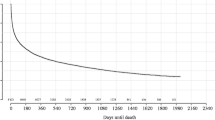Abstract
The integration of mathematical and statistical data analysis research can engender a novel and better approach, especially for survival analysis. This paper is devoted to Professor Pawlak and his ideas about rough sets and its applications. We propose MULTIHYRIS, an alternative hybrid intelligent system with a rough sets and population based approach for survival analysis. MULTIHYRIS is designed to increase the versatility and efficiency of survival analysis techniques. The MULTIHYRIS architecture incorporates mathematics - rough sets (with discernibility relations and individual patient consideration) - with statistics - Kaplan-Meier and Cox methods (with population estimates). The central idea behind MULTIHYRIS is to perform univariate analysis by using rough sets, database management and the Kaplan-Meier method with soft computing.
All results from the univariate analysis are subsequently used in further mulitvariate analysis. In this stage, we provide two optional approaches to serve different requirements; rough sets integrated with database management and the Cox method. The former approach is able to produce decision rules while the latter generates a Cox model. Furthermore, set operations are used to unite these two outcomes and generate new reducts - hybrid reducts based on our rough sets-population based system. The informativeness of the rules and models can be verified within this analysis by validation processes and statistical tests. To demonstrate MULTIHYRIS, we have implemented it on a real-world geriatric data set, collected from the Dalhousie Medical School.
Preview
Unable to display preview. Download preview PDF.
Similar content being viewed by others
References
Pawlak, Z.: Rough Sets. Int. J. Inform. Comput. Sc. 11(5), 341–356 (1982)
Pawlak, Z.: Rough Sets. In: Theoretical Aspects of Reasoning about Data, Kluwer Academic Publishers, Dordrecht (1991)
Pawlak, Z.: Decision Networks. In: Tsumoto, S., et al. (eds.) RSCTC 2004. LNCS (LNAI), vol. 3066, pp. 1–7. Springer, Heidelberg (2004)
Pawlak, Z.: Rough Sets and Flow Graphs. In: Ślęzak, D., et al. (eds.) RSFDGrC 2005. LNCS (LNAI), vol. 3642, pp. 1–11. Springer, Heidelberg (2005)
Pawlak, Z.: Some Remarks on Conflict Analysis. European Journal of Operational Research 166, 649–654 (2005)
Pawlak, Z.: Some Issues on Rough Sets. T. Rough Sets, 1–58 (2004)
Pawlak, Z.: A Treatise on Rough Sets. T. Rough Sets, 1–17 (2005)
Pawlak, Z., Skowron, A.: Rudiments of Rough Sets. Inform. Sciences 177(1), 3–27 (2007)
Pawlak, Z., Skowron, A.: Rough Sets: Some Extensions. Inform. Sciences 177(1), 28–40 (2007)
Pawlak, Z., Skowron, A.: Rough Sets and Boolean Reasoning. Inform. Sciences 177(1), 41–73 (2007)
Bazan, J., et al.: Rough Set Approach to the Survival Analysis. In: Alpigini, J.J., et al. (eds.) RSCTC 2002. LNCS (LNAI), vol. 2475, pp. 522–529. Springer, Heidelberg (2002)
Bazan, J., et al.: Searching for the Complex Decision Reducts: The Case Study of the Survival Analysis. In: Zhong, N., et al. (eds.) ISMIS 2003. LNCS (LNAI), vol. 2871, pp. 160–168. Springer, Heidelberg (2003)
Kaplan, E.L., Meier, P.: Nonparametric Estimation from Incomplete Observations. J. of the Amer. Stat. Asso. 53, 457–481 (1958)
Li, J., Cercone, N.: Discovering and Ranking Important Rules. In: Proc. of the IEEE GrC, Beijing, China, IEEE Computer Society Press, Los Alamitos (2005)
Pattaraintakorn, P., Cercone, N., Naruedomkul, K.: Hybrid Intelligent Systems: Selecting Attributes for Soft-Computing Analysis. In: Proc. of COMPSAC, pp. 319–325 (2005)
Kusiak, A., Dixon, B., Shah, S.: Predicting Survival Time for kidney Dialysis Patients: A Data Mining Approach. Computers in Biology and Medicine 35, 311–327 (2005)
Pattaraintakorn, P., Cercone, N., Naruedomkul, K.: Selecting Attributes for Soft-Computing Analysis in Hybrid Intelligent Systems. In: Ślęzak, D., et al. (eds.) RSFDGrC 2005. LNCS (LNAI), vol. 3642, pp. 698–708. Springer, Heidelberg (2005)
Larry, M.R.: Hybrid Intelligent System. Kluwer Academic Publishers, Boston (1995)
Komorowski, J., Polkowski, L., Skowron, A.: Rough Sets: A Tutorial. In: Pal, S.K., Showorn, A. (eds.) Rough Fuzzy Hybridization: A New Trend in Decision-Making, pp. 3–98. Springer, Heidelberg (1999)
Hu, X., Han, J., Lin, T.Y.: A New Rough Sets Models Based on Database Systems. Fund. Inform. 59(2-3), 1–18 (2004)
Cox, D.R.: The Analysis of Exponentially Distributed Life-times with Two Types of Failure. J. of the Royal Statistical Society 21, 411–422 (1959)
An, A., Cercone, N.: ELEM2: A Learning System for More Accurate Classifications. In: Mercer, R.E. (ed.) Canadian AI 1998. LNCS, vol. 1418, pp. 426–441. Springer, Heidelberg (1998)
Author information
Authors and Affiliations
Editor information
Rights and permissions
Copyright information
© 2007 Springer Berlin Heidelberg
About this chapter
Cite this chapter
Pattaraintakorn, P., Cercone, N. (2007). Hybrid Rough Sets-Population Based System. In: Peters, J.F., Skowron, A., Marek, V.W., Orłowska, E., Słowiński, R., Ziarko, W. (eds) Transactions on Rough Sets VII. Lecture Notes in Computer Science, vol 4400. Springer, Berlin, Heidelberg. https://doi.org/10.1007/978-3-540-71663-1_12
Download citation
DOI: https://doi.org/10.1007/978-3-540-71663-1_12
Publisher Name: Springer, Berlin, Heidelberg
Print ISBN: 978-3-540-71662-4
Online ISBN: 978-3-540-71663-1
eBook Packages: Computer ScienceComputer Science (R0)




